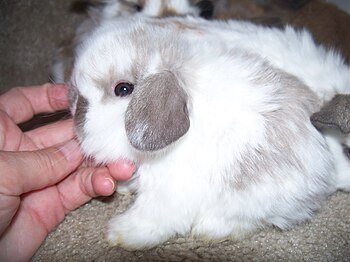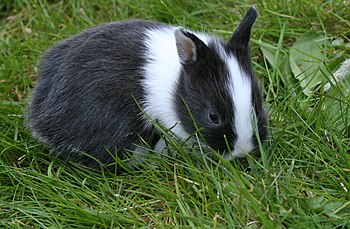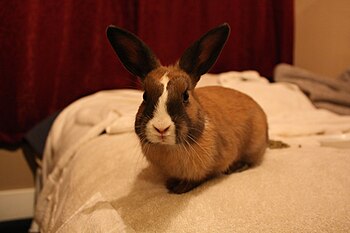Let's talk about how to make a bunny happy! (Because you have to admit, when they're happy, we're happy too!)
 |
| Holland lop show bunny broken sable point (Photo credit: Wikipedia) |
First things first. How do you know when your bunny is happy? Bunnies love to show it! If your bunny flops on her side and just lies there with her eyes closed, you'll know all is right with her world. She might scare you the first time she does this, and it's not uncommon for a new bunny owner to think something is wrong. Don't worry. Your bunny is just telling you she's happy. It's the happy flop.
Then there's the binky. If your bunny binkies, you know she's on top of the world. Binkies are crazy happy dances. Your bunny will hop in the air, twirl her head and spin around then maybe start running at top speed. Any bunny owner will attest to the great joy it brings to see their bun or buns do the binky dance.
Now, how to keep your bunny content? First and foremost is attending to her chewing needs. Bunnies absolutely love to chew. Phone books are popular with bunnies who love to shred the pages, so make sure you keep all of your old phone books (you might even ask your friends and family for theirs.) A bunny can go through a phone book pretty quickly.
Toilet paper and paper towel rolls are also safe and popular chew toys for bunnies. To make it even more fun, you can take a roll and stuff hay inside for them to dig out.
Boxes and paper bags are also a great source of entertainment for bunnies. You can fill the paper bag with hay, or just put an open paper bag on the floor for the bunnies to crawl into and dig. You'll be surprised at how long they can entertain themselves by playing with the bag.
Cardboard boxes are also an incredibly easy source of entertainment. Take a fairly large box and cut several doorways and windows into it. (Bunnies always prefer to have at least two entrances.) Your bunny will love to go in and dig, chew (making the doorways or windows bigger) and hide away. It's also a great place to put your bunny's haywhich she can eat as well as dig. You can also securely tape a bunch of cardboard boxes together, so the bunnies can run through them and play.
Use your imagination and creativity, and you'll find there are endless ways to turn everyday cardboard boxes into a playground for your bunnies.
Article Source: EzineArticles |




